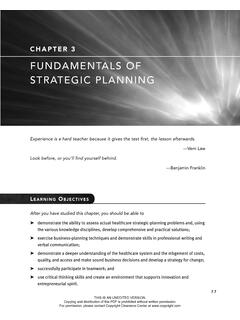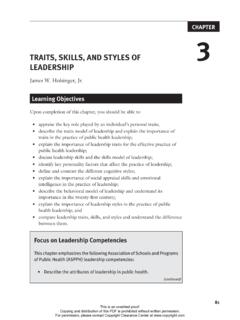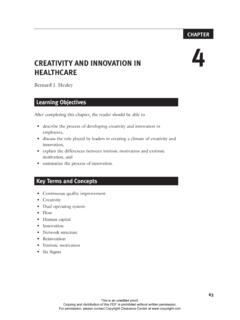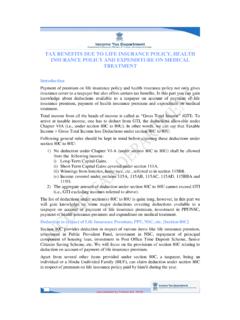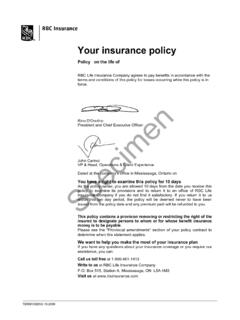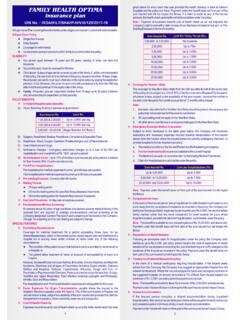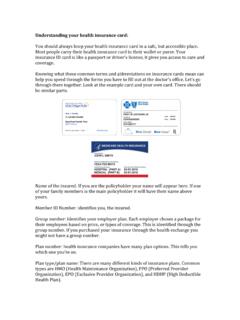Transcription of HEALTHCARE INSURANCE AND REIMBURSEMENT …
1 CHAPTER39 HEALTHCARE INSURANCE AND REIMBURSEMENT METHODOLOGIESI ntroductionFor the most part, the provision of HEALTHCARE services takes place in a unique way. First, often only a few providers of a particular service exist in a given area. Next, it is difficult, if not impossible, to judge the quality of competing services. Then, the decision about which services to purchase is usually not made by the consumer but by a physician or some other clinician. Also, full payment to the provider is not normally made by the user of the services but by a HEALTHCARE insurer. Finally, for most individuals, health INSURANCE from third-party payers is totally paid for or heavily subsidized by employers or government agencies, so many patients are partially insulated from the costs of highly unusual marketplace for HEALTHCARE services has a profound effect on the supply of, and demand for, such services. In this chapter, we discuss the concept of INSURANCE , the major providers of HEALTHCARE INSURANCE , and the methods used by insurers to pay for health ObjectivesAfter studying this chapter, readers will be able to Explain the overall concept of INSURANCE , including adverse selection and moral hazard.
2 Briefly describe the third-party payer system. Explain the different types of generic payment methods. Describe the incentives created by the different payment methods and their impact on provider risk. Describe the purpose and organization of managed care plans. Explain the impact of HEALTHCARE reform on INSURANCE and REIMBURSEMENT methodologies. Explain the importance and types of medical IS AN UNEDITED VERSION. Copying and distribution of this PDF is prohibited without written permission. For permission, please contact Copyright Clearance Center at Finance40 INSURANCE ConceptsHealthcare services are supported by an INSURANCE system composed of a wide variety of insurers of all types and sizes. Some are investor owned, while oth-ers are not-for-profit or government sponsored. Some insurers require their policyholders, who may or may not be the beneficiaries of the INSURANCE , to make the policy payments, while other insurers collect partial or total payments from society at large.
3 Because INSURANCE is the cornerstone of the HEALTHCARE system, an appreciation of the nature of INSURANCE will help you better under-stand the marketplace for HEALTHCARE Simple IllustrationTo better understand INSURANCE concepts, consider a simple example. Assume that no health INSURANCE exists and you face only two medical outcomes in the coming year:Outcome Probability Cost Stay $ 0 Get ,000 Furthermore, assume that everyone else faces the same medical out-comes at the same odds and with the same associated costs. What is your expected HEALTHCARE cost E(Cost) for the coming year? To find the answer, we multiply the cost of each outcome by its probability of occurrence and then sum the products:E(Cost) = (Probability of outcome 1 Cost of outcome 1) + (Probability of outcome 2 Cost of outcome 2) = ( $0) + ( $20,000) = $0 + $200 = $ , assume that you, and everyone else, make $20,000 a year. With this salary, you can easily afford the $200 expected HEALTHCARE cost.
4 The problem is, however, that no one s actual bill will be $200. If you stay healthy, your bill will be zero, but if you are unlucky and get sick, your bill will be $20,000. This cost will force you, and most people who get sick, into personal , suppose an INSURANCE policy that pays all of your HEALTHCARE costs for the coming year is available for $250. Would you purchase the policy, even though it costs $50 more than your expected HEALTHCARE costs? Most people would. In general, individuals are risk averse, so they would be willing to pay a $50 premium over their expected costs to eliminate the risk of financial THIS IS AN UNEDITED VERSION. Copying and distribution of this PDF is prohibited without written permission. For permission, please contact Copyright Clearance Center at 2: HEALTHCARE INSURANCE and REIMBURSEMENT Methodologies41ruin. In effect, policyholders are passing to the insurer the costs associated with the risk of getting an insurer be willing to offer the policy for $250?
5 If an INSURANCE company sells a million policies, its expected total policy payout is 1 million times the expected payout for each policy, or 1 million $200 = $200 mil-lion. If there were no uncertainty about the $20,000 estimated medical cost per claim, the insurer could forecast its total claims precisely. It would col-lect 1 million $250 = $250 million in health INSURANCE premiums; pay out roughly $200 million in claims; and hence have about $50 million to cover administrative costs, create a reserve in case realized claims are greater than predicted by its actuaries, and make a Characteristics of InsuranceThe simple example of health INSURANCE we just provided illustrates why indi-viduals would seek health INSURANCE and why INSURANCE companies would be formed to provide such INSURANCE . Needless to say, the concept of INSURANCE becomes much more complicated in the real world. INSURANCE is typically defined as having four distinct characteristics:1.
6 Pooling of losses. The pooling, or sharing, of losses is the heart of INSURANCE . Pooling means that losses are spread over a large group of individuals so that each individual realizes the average loss of the pool (plus administrative expenses) rather than the actual loss addition, pooling involves the grouping of a large number of homogeneous exposure units people or things having the same risk characteristics so that the law of large numbers can apply. (In statistics, the law of large numbers states that as the size of the sample increases, the sample mean gets closer and closer to the population mean.) Thus, pooling implies (1) the sharing of losses by the entire group and (2) the prediction of future losses with some Payment only for random losses. A random loss is one that is unforeseen and unexpected and occurs as a result of chance. INSURANCE is based on the premise that payments are made only for losses that are random. We discuss the moral hazard problem, which concerns losses that are not random, in a later Risk transfer.
7 An INSURANCE plan almost always involves risk transfer. The sole exception to the element of risk transfer is self- INSURANCE , which is the assumption of a risk by a business (or an individual) itself rather than by an INSURANCE company. (Self- INSURANCE is discussed in a later section.) Risk transfer is transfer of a risk from an insured to an insurer, which typically is in a better financial position to bear the risk than the insured because of the law of large IS AN UNEDITED VERSION. Copying and distribution of this PDF is prohibited without written permission. For permission, please contact Copyright Clearance Center at Finance424. Indemnification. The final characteristic of INSURANCE is indemnification for losses that is, REIMBURSEMENT to the insured if a loss occurs. In the context of health INSURANCE , indemnification takes place when the insurer pays the insured, or the provider, in whole or in part for the expenses related to an insured s illness or SelectionOne of the major problems facing HEALTHCARE insurers is adverse selection.
8 Adverse selection occurs because individuals and businesses that are more likely to have claims are more inclined to purchase INSURANCE than those that are less likely to have claims. For example, an individual without INSURANCE who needs a costly surgical procedure will likely seek health INSURANCE if she can afford it, whereas an individual who does not need surgery is much less likely to purchase INSURANCE . Similarly, consider the likelihood of a 20-year-old to seek health INSURANCE versus the likelihood of a 60-year-old to do so. The older individual, with much greater health risk due to age, is more likely to seek this tendency toward adverse selection goes unchecked, a dispropor-tionate number of sick people, or those most likely to become sick, will seek health INSURANCE , and the insurer will experience higher-than-expected claims. This increase in claims will trigger a premium increase, which only worsens the problem, because the healthier members of the plan will seek INSURANCE from other firms at a lower cost or may totally forgo INSURANCE .
9 The adverse-selection problem exists because of asymmetric information, which occurs when individual buyers of health INSURANCE know more about their health status than do today s world of health reform, ushered in by the Patient Protection and Affordable Care Act (ACA; introduced in Chapter 1), which requires insur-ers to take on patients regardless of preexisting conditions, the best strategy for HEALTHCARE insurers to combat adverse selection is to create a large, well-diversified pool of subscribers. If the pool is sufficiently large and diversified, the costs of adverse selection can be absorbed by the large number of enrollees. Moral HazardInsurance is based on the premise that payments are made only for random losses, and from this premise stems the problem of moral hazard. The most common case of moral hazard in a casualty INSURANCE setting is the owner who deliberately sets a failing business on fire to collect the INSURANCE .
10 Moral hazard is also present in health INSURANCE , but it typically takes a less dramatic form; few people are willing to voluntarily sustain injury or illness for the purpose of collecting health INSURANCE . However, undoubtedly there are people who purposely use HEALTHCARE services that are not medically required. For example, some people might visit a physician or a walk-in clinic for the social value of Adverse selectionThe problem faced by INSURANCE companies because individuals who are more likely to have claims are also more likely to purchase hazardThe problem faced by INSURANCE companies because individuals are more likely to use unneeded health services when they are not paying the full cost of those IS AN UNEDITED VERSION. Copying and distribution of this PDF is prohibited without written permission. For permission, please contact Copyright Clearance Center at 2: HEALTHCARE INSURANCE and REIMBURSEMENT Methodologies43human companionship rather than to address a medical necessity.
